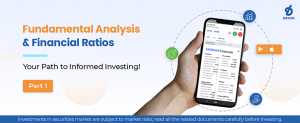Understanding Fundamental Analysis amp Financial Ratios I ValuationMultiples
![]() July 22, 2024
July 22, 2024
![]() 0 Comments
0 Comments
There’s an old adage - “If you fail to plan, you plan to fail.” This is true in stock investing and stock trading as well. Investing in stocks entails multi-layered research and analysis, in which fundamental analysis is a crucial part. Fundamental analysis is a valuable tool for evaluating the financial health and performance of a company which involves assessing a company's financial statements, profit, revenue, expenses, assets, and liabilities to determine its intrinsic value and potential for growth. This analysis can provide insights into the company's current and future financial health and can help you make informed investing decisions.
Through our upcoming blogs, we aim to equip you with the knowledge and tools necessary to make well-informed investment decisions based on fundamental analysis. Remember, knowledge is the key to successful investing, and we are excited to embark on this learning journey with you. Stay tuned for the upcoming blog posts, and let's uncover the power of financial ratios together.
In our first piece, we will focus on valuation multiples. These ratios help us compare a company's stock price with its profits, book value, and cash flow.
What are Valuation Multiples
All that glitters is not gold. This is specifically true for companies listed in the stock market. A listed company can ‘appear’ attractive and valuable. However, the true valuation of a company shows the true picture. A company might appear attractive and fundamentally strong but may not be reasonably priced. Looking at the valuation metrics will enable you to understand its actual value. Understanding the valuation of a company will help you understand if the company is undervalued or overvalued, in effect allowing you to make your investment decision wisely. Below we look at four key valuation multiples and how you can use them in your investing journey.
Types of Valuation Multiples:
Price To Earnings Ratio or P/E Ratio
What is P/E?
The P/E ratio relates a company's share price to its earnings per share (EPS). It reflects the amount investors are willing to pay for each rupee of the company's earnings. A high P/E ratio typically suggests that the market expects strong future growth, while a low P/E ratio may indicate that the company's earnings growth prospects are uncertain or modest.
Formula: To calculate the P/E ratio, you can divide the stock price of a company by its earnings per share (EPS) or its market cap by its net profit.
P/E ratio = Stock Price per Share / Earnings per Share
Check out the P/E of top Indian companies here
How to Use P/E Ratio to Make Data-Driven Decisions?
- A very high P/E ratio might imply heightened risk since the market's expectations may be difficult to meet. Similarly, a low P/E ratio could indicate that investors have concerns about the company's growth potential or financial stability.
- By comparing the P/E ratios of different companies within the same industry or sector, you can identify undervalued or overvalued stocks. A relatively low P/E ratio might suggest an opportunity to invest in an undervalued company, while a high P/E ratio could indicate an overpriced stock.
- A higher P/E ratio often indicates strong growth expectations, implying that investors believe the company will experience significant earnings growth in the future. Conversely, a lower P/E ratio may signal more modest growth prospects.
Things to keep in mind:
- P/E ratios can vary significantly among industries. Hence, like any financial ratio, you should compare ratios between similar companies. Comparing the P/E ratios of companies from different sectors might not provide an accurate assessment, as some industries typically have higher or lower P/E ratios.
- One of the key inputs in calculating the P/E is EPS, which is found in the company’s income statement. Companies can manipulate earnings figures to influence their P/E ratio artificially. Hence, look for unusual patterns, inconsistent figures, or sudden changes in financial ratios over time.
- Companies with irregular earnings or those experiencing temporary setbacks may have distorted P/E ratios that don't accurately reflect their true valuation.
Price to Book Value
What is the P/B ratio?
The P/B ratio is used to assess a company's share price relative to its book value per share. It provides insights into whether a stock is trading at a premium or discount compared to its accounting value. The book value represents the net asset value of a company, calculated as the difference between its total assets and total liabilities.
Formula: To calculate the P/B ratio, you can divide the stock price of a company by its book value per share (BPS) or its market cap by its book value.
P/B ratio = Stock Price per Share / Book Value per Share
Check out the P/B of top Indian companies here
How to Use P/B Ratio to Make Data-Driven Decisions?
- Similar to P/E, comparing the P/B ratios of companies within the same industry or sector allows you to identify stocks that may be undervalued or overvalued. A P/B ratio of 1 or below is generally regarded as an undervalued stock by value investors, but most companies do not have a P/B of less than one– market value is at a premium to book value for most companies. If it is the other way around, it can even be a red flag for you to look out for. For P/B, a comparison with industry peers is preferable.
- The P/B ratio helps you assess how much you are paying for a company's net assets. A lower P/B ratio might indicate that the stock is attractively priced in terms of its book value, making it an appealing investment opportunity.
- Companies with a P/B ratio less than 1 might signal financial distress or poor market sentiment, while those with a ratio above 1 could indicate market optimism and investor confidence.
Things to keep in mind:
- The P/B ratio only considers tangible assets and doesn't account for intangible assets like intellectual property, brand value, or patents, which could be significant for certain companies. Companies in the technological sphere or software services may not have the majority of their assets in tangible form.
- The book value is an accounting measure – based on historical costs and doesn't necessarily reflect the current market value of the company's assets. As a result, the P/B ratio may not fully represent the company's true value.
- Companies with high debt may have lower book values, leading to potentially misleading P/B ratios. Debt levels should be considered alongside the P/B ratio for a comprehensive analysis.
EV/EBITDA
What is EV/EBITDA?
The EV/EBITDA ratio provides insights into how the market values a company's core operations before accounting for financing decisions, taxes, and non-cash items. Unlike the market cap of a company which is used for P/E, P/B, and P/CF, the Enterprise Value (EV) includes a company's market capitalization, debt, and minority interest, while EBITDA represents its profit before interest, taxes, depreciation, and amortization.
Formula: To calculate the EV/EBITDA ratio, divide the Enterprise Value by the EBITDA. EV/EBITDA ratio = Enterprise Value / EBITDA
Where Enterprise Value = Market Capitalization + Total Debt - Cash and Cash Equivalents
Check out the EV/EBITDA of top Indian companies here
How to Use EV/EBITDA Ratio to Make Data-Driven Decisions?
- Similar to the above valuation multiples, EV/EBITDA ratios of companies within the same industry or sector allow you to identify potential investment opportunities. A lower ratio might suggest an undervalued company, while a higher ratio could indicate an overvalued stock.
- The ratio considers a company's debt as part of its valuation, making it useful for comparing companies with varying debt levels. A high EV/EBITDA ratio may indicate higher financial risk due to substantial debt.
Things to keep in mind:
- EV/EBITDA does not take into account capital expenditures (CapEx). By excluding capital expenditures from the calculation, the EV/EBITDA ratio may provide a more favorable valuation multiple for companies that heavily rely on capital-intensive operations.
- Another limitation of EV/EBITDA is that it disregards non-cash expenses, such as amortization and depreciation. By not considering these non-cash expenses, the ratio can present an incomplete picture of a company's financial performance as it fails to account for the impact of these expenses on a company's actual cash generation ability.
P/CF
What is the P/CF ratio?
The Price-to-Cash Flow ratio, or P/CF ratio, is used to assess a company's stock valuation relative to its operating cash flow per share instead of its earnings or book value. It provides insights into how the market values a company's ability to generate cash from its core operations.
Formula: To calculate the P/CF ratio, divide the company’s share price by its operating cash flow per share.
P/CF ratio = Stock Price per Share / Operating Cash Flow per Share
Check out the P/CF of top Indian companies here
How to Use P/CF Ratio to Make Data-Driven Decisions?
- P/CF can identify potentially undervalued or overvalued stocks. A lower P/CF ratio might indicate that a stock is attractively priced in terms of its cash flow generation, while a higher ratio could suggest an overvalued stock. Again, comparison with peers is crucial.
- The multiple works well for companies that have large non-cash expenses such as depreciation. It can also be used in companies where you are doubtful of the reported earnings.
Things to keep in mind:
- Different industries may have varying capital requirements and cash flow patterns, making direct comparisons across sectors less meaningful.
- Companies may use different accounting methods, affecting their reported cash flows and leading to discrepancies in the P/CF ratio.
Significance of Valuation Multiples Analysis in Investment Decisions
Combining multiple valuation multiples provides a comprehensive and nuanced view of a company's valuation. Remember that every company is unique, and the interpretation of multiples should be done in context. A well-rounded analysis that combines the above multiples, industry benchmarks, and qualitative factors will help you make informed investment decisions and understand the overall valuation of a company better.
While fundamental analysis is a valuable tool for evaluating the financial health and performance of a company, you must remember that it is not the ultimate test to select the best stocks. Investing in the stock market is a complex and multifaceted process that involves considering a variety of factors. Successful investors often use a combination of fundamental and technical analysis, along with an understanding of market sentiment, industry trends, competitive landscape, and broader economic trends, to make well-informed investment decisions.
Thank you for joining us on this insightful journey exploring valuation multiples and their significance in assessing a company's financial health. We hope that this blog has shed light on the importance of these metrics in determining a company's value and potential for investment. As we continue our series on financial ratios, we invite you to stay tuned for our upcoming blog that delves into profitability ratios. These ratios, such as Net profit margin, Return on Equity (ROE), Return on Assets (ROA), and others, are instrumental in evaluating a company's ability to generate profits and manage expenses efficiently. Understanding a company's profitability is crucial in gauging its long-term sustainability and potential for growth.
If you have a question, share it in the comments below or DM us or call us – +91 9051052222. We’ll be happy to answer it.
~ Dimensions, Nischay Avichal
Share With
I'm a cool paragraph that lives inside of an even cooler modal. Wins!
Are you sure?
In case you didnt know, you can open your account online within 24 hours. Offline account opening takes up to 4 working days. If you wish to open your account offline, fill and sign the forms using a black/blue ballpoint pen. Please fill in the email and mobile number of the applicant to avoid account opening delays.
Enter Password
Please enter your details and password
New to Dayco?
Enter Password
Please enter your details and password
New to Dayco?
Filing Complaints on SCORES (SEBI) – Easy & Quick
- Register on SCORES Portal (SEBI)
- Mandatory details for filing complaints on SCORES:
- Name, PAN, Address, Mobile Number, E-mail ID
- Benifits:
- Effective Communication
- Speedy redressal of the grievances
Thanks !!
Your details were successfully received.

Thank you for Your Feedback!
Our Team is working constantly on improving our user experience and your feedback really means a lot.
Thanks !!
App Link Send to your mobile number successfully.
Thank You
All your Questions have been recorded
Thank You
All your Questions have been recorded
Thank You!
Thank you for your response. We'll get in touch with you at the earlisest for your investment planning needs
NEXT
Thank You!
Thank You for your interest in our Moderate Equity Portfolio. Please find below the credentials to track this portfolio:
User ID: mockmod@daycoindia.com
Password: abcd@1234
Portfolio Tracker
Please Read!
Risk profiling is crucial for identifying and managing potential risks in investment decisions. Please carry out your risk profiling before making any investment decisions.
Complete Risk Assessment Now
Thank You !!
Please enter your details to download/print the report
Thank You !!
Please enter your details to download/print the report
Thank You !!
Please enter your details to download/print the report
Thank You !!
Please enter your details to download/print the report
Thank You !!
Please enter your details to download/print the report
Set Your Goal
Please Select an option from below
Set Your Goal
Please Select an option from below
Thanks You !
We appreciate your interest in our services. Our team will be in touch with you shortly.
CloseSet your Goal
Please enter your details in the fields provided
Thanks You!!
Calculation report has been sent to your mail id successfully
Clear form?
This will remove your answers from all questions and cannot be undone.



 Book Appointment
Book Appointment









Leave a Reply